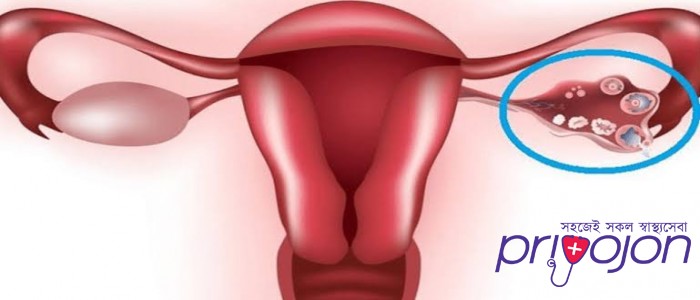
Overview
Medically reviewed by Dr. Rabeya Afroz Shomi
What is Ovarian Cysts?
Can ovarian cysts cause cancer?
What is the explanation for Ovarian Cysts?
What are the symptoms of Ovarian Cysts?
What are the treatment of Ovarian Cysts?
What are the Side effects of Ovarian Cysts treatment ?
What is Ovarian Cysts?
Ovaries are the feminine genital system part, which located on each side of the uterus within the lower abdomen. Ovaries produce eggs along side hormones estrogen and progesterone. Cysts may be a fluid filled sacs, which is developed in one among the ovaries. In most of the cases, cysts don’t develop any symptoms and cause no pain. There various sorts of cysts like dermoid cysts, endometrioma cysts, follicle, endocrine gland cysts and polycystic ovary syndrome which may cause infertility in woman.
Can ovarian cysts cause cancer?
Ovaries are the organ located deep within the pelvis. during a maximum number of cases, cysts don’t develop any quite pain. But cysts are some things which has fluid and sac filled.
Fluid, follicle or tumor within the cysts doesn’t mean it cause cancer. it's a sort of condition which affects almost every woman, ones in their life. But most of it doesn’t develop ovarian cancer.
What is the explanation for Ovarian Cysts?
Ovarian Cysts are sacs crammed with fluid, occurring in women mainly during their ovulation period. These Cysts commonly don’t have any symptoms and are usually harmless. the essential function of the ovaries is to supply an egg monthly , this is often called ovulation. During this point , a cyst like structure gets formed inside the ovary. this is often referred to as a Follicle. The mature follicle fractures when an egg is released during ovulation. The empty follicle results in the formation of a endocrine gland and, if pregnancy doesn't arise, the endocrine gland dissolve. Yet, sometimes, this process doesn't complete accordingly, cause the foremost common sort of cyst which is that the functional ovarian cysts. along side this, cysts also can occur due to reasons like Endometriosis during which women affected by endometriosis can flourish a kind of cyst called an endometrioma and Severe pelvic infections which may spread to the ovaries or Fallopian tube leading to the formation of cysts.
What are the symptoms of Ovarian Cysts?
Nausea and vomiting
Breast tenderness
Painful sex
Pelvic pain
Bloating
Inflammation
Lower back pain
What are the treatment of Ovarian Cysts?
The ovaries are a part of the feminine genital system . They’re located within the lower abdomen on each side of the uterus. Women have two ovaries that produce both eggs and progesterone and hormones estrogen.
Sometimes, a fluid-filled sac called a cyst will develop on one among the ovaries. Most of the ladies will grow a minimum of one cyst during their lifespan. In most cases, ovarian cysts are painless and cause no conditions.
Treatment for an cyst are mentioned below:
The doctor may advise treatment to scale back the dimensions or remove the cyst if it doesn’t get away on its own or if it grows further.
Birth control pills: If you've got recurring ovarian cysts, the doctor may specify an pill to prevent ovulation and prevention for the event of latest cysts. Oral contraceptives also can decrease your possibilities of ovarian cancer. the likelihood of ovarian cancer is higher in postmenopausal women.
Laparoscopy: If your cyst is little in size and results from an imaging test to rule out cancer, the doctor can perform a laparoscopy to surgically remove the cysts. the tactic involves your doctor making alittle incision on the brink of your navel then implanting alittle instrument into your abdomen to get rid of the cyst.
Laparotomy: If you contain an outsized cyst, your doctor can surgically remove the cyst through an outsized incision in your abdomen. aside from this, they're going to conduct an urgent biopsy, and if they determine that the cyst is cancerous, they'll perform a hysterectomy to get rid of your ovaries and uterus.
What are the post-treatment guidelines for Ovarian Cysts?
Treatment of ovarian cysts depends on various factors, like the dimensions and sort of cyst, the woman's age and general well being, future pregnancy intentions of the patient. the sooner these cysts are observed, the more easy the treatment would be. In some cases, the ovarian cysts don't require any treatment. during a postmenopausal patient, a repeated simple cyst smaller than 10 cm in size, along side the presence of a traditional CA125 value could also be followed with serial ultrasonographic examinations. If the cysts are but 5 cm in size, no further investigation is required and there's no risk. If the dimensions is 5-7 cm, these ovarian cysts detected in premenopausal women are functional and most of the functional cysts will have resolved within 2 months. Therefore, an ultrasound should be repeated at 6 months, with CA 125 as long as a cyst remains there. CA 125 isn't required at the present . Non-functional benign cysts usually remain unchanged.
What are the Side effects of Ovarian Cysts treatment ?
Most ovarian cysts are benign and get away on their own without the right treatment. These cysts cause little if any, symptoms. But in some cases, doctors may discover a cancerous cystic ovarian mass during a periodic examination.
Ruptured cysts, can cause intense pain and bleeds internally. This complication the danger of an infection and may be very dangerous if not treated.
Ovarian torsion is another severe complexity of the ovarian cysts treatment. this is often when an outsized cyst causes an ovary to twist or move from its own original state. Blood supply to the ovary is stop , and if not treated, it can cause injury or death to the ovarian tissue. aside from this, exceptional, ovarian torsion reports for nearly 3 percent of emergency gynecologic surgeries.
